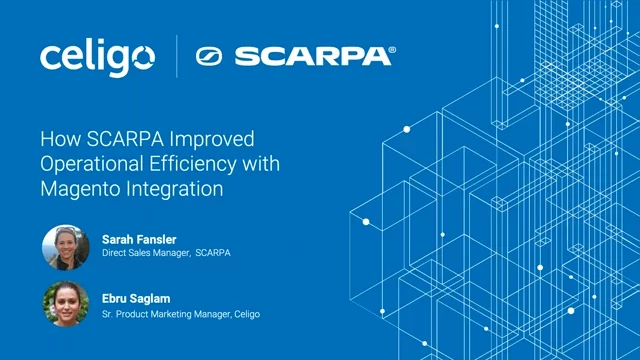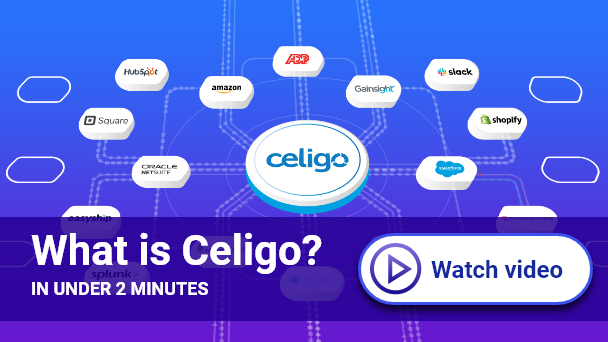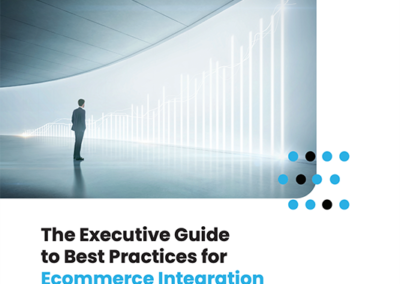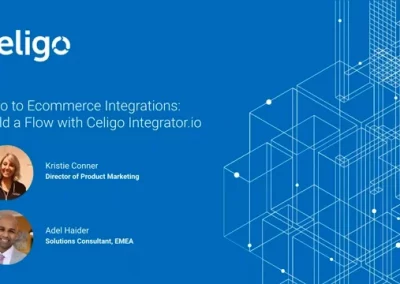Full Webinar Transcript
Hello, everyone. Thank you for joining this webinar. My name is Ebru and I work in Product Marketing at Celigo. So I am excited to have one of our customers, Sarah Fansler, from SCARPA, as our guest speaker today. So Sarah is the Direct Sales Manager at SCARPA and her e-commerce and outdoor industry experience has helped SCARPA significantly grow their direct to consumer business over the five years. And today, Sarah will talk about their e-commerce operations, their journey from a custom built integration to Celigo’s Magento integration, and also, she’ll talk about how automation through integration helped them improve their operational efficiencies. So if you have any questions during this presentation, you can submit them through the questions pane and we’ll be answering them at the end of the session. So here’s first some background on Celigo. We’re an iPaaS integration platform as a service company and we’re a global company with more than 3000 customers. We have been in the Gartner Magic Quadrant over the past couple of years and we are also a G2 iPaaS leader. We have great customer reviews and you can see some of our retail and e-commerce customers here. And Magento, Amazon, Shopify, eBay, Zendesk, and 3PL are some of our most popular integrations we see our customers are using. And some information on our platform. So on our platform, you can connect any application to any other application and you can automate your business processes. So we see e-commerce companies and they mainly use our platform to automate their order to cash processes. And one of the things that makes our platform unique is that it is intuitive enough to be used by business users but also it has all the advanced capabilities to support the needs of highly technical users. And as part of our solutions, we have pre-built integration apps that are fully managed SaaS apps that are built and run on the platform. And these apps, they cover the most common integration use cases so that our customers can quickly get started with their integrations instead of having to build those integrations from scratch. And the Magento NetSuite integration apps Sarah is going to talk about is one of those and you will learn more about it later in the presentation. And so yeah. And here is again an overview of the e-commerce landscape. So when it comes to e-commerce, I can easily say that today, Celigo has solutions to support pretty much any business process. Anything you see here can be connected with each other for automation. So ERPs, marketplaces, point of sale systems, 3PLs, online storefronts, of course, and customer support systems are just some of the examples. And now, I will hand it off to Sarah and as I mentioned, if you have any questions, you can just type them into the questions pane and we’ll be addressing them at the end of the session. And now, I will let Sarah introduce herself. Hello, Sarah. Hello. Hello, everyone. As Ebru mentioned, I’ve been working at Scarpa for five years. I’m the Direct Sales Manager and manage all of our direct-to-consumer channels, including our e-commerce channels for Scarpa. I’ve worked across the outdoor industry, and an avid skier myself. And so, this was an interesting talk. I’m excited to talk to you all about a little bit of our experience. You can go to the next slide, Ebru. All right. So a little bit about Scarpa itself. We are over an 80-year-old company, founded in 1938 in the northern Italian region. It’s still a family-owned company and very much still feels like a small company even though we’re much larger these days. We make outdoor footwear that really is performance-driven and purpose-built, so really kind of any kind of mountain sport that you’re interested in, we make technical footwear for that. Our products are still handmade in Europe and designed for, really, the highest performance in every sport category. Here, I’ve listed a bunch of the different sports that we make technical footwear for. We call it 360 degrees of sports for the mountains, but, really, anything you want to do in the mountains, we make something that probably will suit your needs and is really well, sort of, designed and crafted. Like I said, we’re a global company. We have subsidiaries across the globe and over 40 countries these days. The Scarpa North America is where I work and we opened our headquarters in 2005 and have our distribution center and headquarters located in Boulder, Colorado. A bit of an overview of Scarpa’s business at a glance, so a little bit about how we operate. We have fully vertical production. That means we fully own our manufacturing facilities in Europe and Asia and make our own products all the way through from design to sales of that product. So we fully own the process all the way through. Scarpa North America, we do help with product development, but for the most part, we oversee the sales and marketing and distribution for the US and Canada. We currently, in the United States and Canada, sell through multiple channels. Historically, our business has been wholesale and that’s been the foundation of our business. Particularly, we focus on specialty retail, like most outdoor gear that makes– or companies that make technical gear, we definitely rely on specialty retail. And we do sell through chain Outdoor Outfitters as well, as well as internet retailers, and most recently gyms as well. The direct-to-consumer channels are definitely newer to Scarpa. We have definitely expanded a bit in the last few years as people take to online and it’s easier to sell technical gear through the internet, and we manage our own e-commerce platform and multiple online marketplaces as well. In recent years, we’ve definitely seen some of the strongest growth in our company through direct-to-consumer channels and have consistently outpaced the market, recently, as well. So it’s definitely the area to business that’s getting a lot of attention and something that we’re always keen to improve. We currently fulfill most orders out of Boulder, Colorado but also have distribution out of Canada through a 3PL that is based in Kamloops. A bit of background about our e-commerce history at SCARPA. Right now, we use NetSuite as our ERP. We have for a long time. It is our true master system and everything really flows through NetSuite or into NetSuite. We’ve migrated originally a few years ago from a small open source e-commerce platform that most of you probably have never heard of. And then moved on to the Magento community platform in 2017 with a full rebuild of our website. And at that time, we launched with a custom integration tool, a custom integration application that we built with an external development team. That application did our order-to-cash process for us in a sort of limited way, we did the inventory, customer records, order information, fulfillment, and credit memos. And that was pretty much the extent of what the application did. We did that slightly after launch. Initially, we were manually entering, and then soon after launch, we launched with the integration application. All of the orders were processed through Magento and then distributed out of Boulder, Colorado. And I’ve listed here a few of the different records and how we sort of push them around. Really from Magento, we were bringing in customer and order information. And then from NetSuite, we were taking out the inventory information, the fulfillment information, and actually, credit memos as well were being processed in NetSuite and then pushed back to Magento. And then as some in product information as well just initially a little bit. We didn’t do too much of that but that was pretty much the extent and we changed it a few times over which items we were bringing. But that was what we ended up with at the very end of the implementation. So with the custom integration, it was an interesting process. We learned a lot about our business processes. But ultimately, it was a pretty challenging experience. We ended up going with the development team that was recommended to us by NetSuite. And they were a strong development team that built the application in terms of their experience with NetSuite. But it turns out they were not as familiar with Magento and that left some gaps in knowledge during the build itself. And so, when it was all said and done, the application required a lot of adjustments, a lot more than you’d expect, and a lot of errors. So what we ended up having to manage was when something would create an error, the team, the customer service team, and those that were doing order entry would have to go in and actually adjust the individual records to either review for errors or adjust an error if we found one. That was not only necessary for both customer records and order records but also inventory management as well occasionally. At times the application would fail completely. We ended up spending additional money to try to fix the broken application. And that was a very challenging process that was rather time-consuming as well. One of the biggest things we saw that was apart from the day to day management was that it was quite slow to run. So it was not built off of a token-based system. And so, it took quite a while to run particularly feeds like the inventory and so, we ended up running those overnight, for the most part, in our off hours. That meant that most of our information was not real time, and that was pretty frustrating for a custom application to have that experience. We spend a lot of time, like I said, adjusting orders and troubleshooting problems, and this took the team away from really providing that next level of customer service that our customers had come to expect and took us away from a lot of other forward looking tasks. One of the other challenging pieces of this was because humans were involved in overseeing all of the orders, if something was missed, that resulted in a lot of poor communication to customers. Obviously, if the quantity on an order is wrong or something like that, you have a pretty unhappy customer, so that was not a great outcome. And then, when we went to troubleshoot or work on the integration and fixing it, we really only had some pretty basic error logs to work off of, and so, we were working, in many ways, without much visibility on how or what to fix, and it took a lot of back and forth to find the errors. And then, obviously it’s a dynamic landscape. Ecommerce landscape is dynamic, and our business needs change at times, so when we had modifications that we needed to make, that was an expensive endeavor and time consuming to go through that build process each time. So when we started the process of looking for a better solution, we ended up looking at a lot of different candidates. I think we researched something like seven to eight different companies or programs that we wanted to potentially work with, and we ended up kind of coming down to sort of our list of what was really important to us. Obviously, it needed to be robust and a good value. It needed to do everything we were doing before and more, but we also wanted it to be easy enough for non developers to use and modify, and that’s because we don’t actually have a developer in house at Scarpa, and we wanted to make sure that regardless of who implemented the tool, we were able to use it and modify it and improve it no matter who was managing it at that time. We also really wanted to make sure we had good visibility into the troubleshooting and that process. The error logs we were receiving before were rather cryptic, and it definitely was its own job just to find the errors and what they were, and so, having visibility into what was actually happening on the integration, and actually being able to get a view of that makes everything much faster if anything does occur. It obviously needed to be reliable and allow us to expand our needs, and one of the things that we found really challenging was while it seems cost effective to build an application that you pay for once, the maintenance on that and building out anything else you want to do is additional cost that adds up rather fast, and so, we wanted something that could expand as our needs change and would have a lot of options for us to improve or change or add without much additional cost. We looked for things that would be much more real time, and so, obviously, with our inventory feed running before only mostly overnight and customer and order records only running a handful of times a day, that caused a number of problems, and we needed it to be much more real time, whatever tool we ended up going with. And then, most companies, when you go to research them, will tell you that they offer great support and great implementation, so one of the things we ended up looking at were customer reviews and looking for a team that would really actually provide the support that we might need, just in case, during not only implementation, but should anything change or go wrong. So when we finally ultimately decided, we decided to go with Magento to NetSuite, and that’s the integration app, and, as Ebru mentioned, this is sort of a stock application that has a lot of the order to cash processes already built. That was really attractive, because we wanted to be able to get up and running quickly, and we wanted to be able to not have to build out absolutely every single detail. Most of our processes are pretty straightforward. Obviously some are unique or custom, but, for the most part, they’re traditional order to cash processes, and we wanted to be able to use sort of a stock tool for the most part. And so, once we went with the application, we automated our order to cash operations that we had before. So that was our inventory feed, customer records, orders fulfillment, credit memos, and then, some product information as well. We ended up actually not even using everything that the tool offers, even though we plan to. It offers a lot of stock options that are even more robust than we had with our previous application, and, because of our business operations, haven’t even had the chance to use everything that the tool offers, which is a great place to be in. The implementation itself was quite smooth. I think in part of the phenomenal customer success manager who helped us through the process, we had weekly meetings with her and it was night and day in terms of her knowledge of both Magento and NetSuite. And so having gone through the process with an external team who didn’t have that depth of knowledge in both systems, we really felt the difference when we moved to the Celigo team and that was huge. For the most part, most of our items were pretty standard and she helped sort of navigate and orient us on the new application and tool. But when we had more custom needs, she was able to really just help us find good ways to map things and not overly complicate the business processes that we wanted to achieve. It was pretty intuitive so once she gave us some basic instructions, we were able to go back and then continue to build things out and do it on our own. Like I said, we don’t have a developer in-house. We have basic technical knowledge in our team of integration tools, but we were able to go in and use it pretty independently with some basic instruction. And we also found it pretty customizable. We don’t have a ton of unique processes but we do have a few rather complicated customer rules and things like that and we are able to modify and really bring in that information that we wanted in the way we wanted, which was awesome. One of the other things that this allowed us to do is really actually totally revamp how we were scheduling and automating the integrations. We were able to set up automatic schedules. I believe we’re running many of them as frequently as every 15 minutes. We were able to do big seasonal updates so we don’t even have to touch the automatic ones in seasonal updates. When we have big pushes of information, we do more manually but we have complete control over that and it’s really easy to dial up or down. And then we do regularly modify the integrations as our businesses change and it’s fairly straightforward to go in there and adjust something or modify or add a new customer group or things like that. So once the Celigo integration app was implemented, we really saw huge improvements. It was phenomenal, pretty much right off the gate. So one of the things we saw right away was a huge reduction in errors and information transfer. We really saw a lot– the teams spend a lot less time reviewing and checking orders and correcting orders, which is a huge part of any tool that you’re looking for. We did not have to spend a lot of time maintaining it. So one of the things we were doing before is pretty much daily checks on the application itself, the old application we had. With this new tool from Celigo, we really automated the system and set it and we’re done. Unless something changed or aired, we really didn’t go and check it. And so something we were doing daily went down to really a weekly modification of us needing to go and just do something that we wanted to do. The speed of the integration was much faster so our inventory became real time and this has been great. This means that our customer experience is much stronger. Inventory on our website is actually reflecting what we truly have. This has reduced call volume for the customer service team and provided a much better experience for both customers and in-house staff. Our team has had to spend a lot less of their time on really any part of this. If something goes wrong it’s probably something that we’ve done that we’ve changed and do not realize when in fact the integrations. And for the most part, the team is able to really focus on forward-looking projects and really actually the meat of what their job should be, which is focusing on customer experience and communication. With our old application, like I mentioned before, we spent a lot of time hunting down errors, so looking at those bad error logs and trying to find out even what the issue was. With the new tool, it’s really easy to go in, and the problem, if there was one, is pretty straightforward. It tells you right there. The errors are pretty clear. It’s easy to go in and troubleshoot and find whatever you’ve done, maybe you’ve got a shipping method and didn’t add it to the mapping or something like that. It’s pretty easy to see what’s going on and actually modify it as you need. Really, we’ve had very few problems, and we’re able to update with ease. So we’ve had a few business processes that have changed. We’ve changed our operations on how we want things managed in NetSuite, for example, and we’ve been able to go in and completely update a flow to meet that need in NetSuite without much effort and without needing to call anyone from Celigo or ask for assistance. We’ve been able to guide ourselves, which is really nice to be able to operate independently and quickly. And then as our direct to consumer business needs grow, we plan to be able to scale the business. So we have a lot of other areas of the direct to consumer business that we will be integrating are moving forwards, and we have a lot of seasonal volume that we would not have been able to handle, particularly this year that we’ve been able to manage much more efficiently, not only seasonal with sport. We obviously sell ski gear, and that’s a seasonal business, but we also have holiday season like everyone else. So we’ve been able to actually manage more with less, which is always the goal of any new implementation that was a really nice treat. And this is just a bit about what we hope to do with the Celigo platform this year. We have a new Canadian online store on Magento that we’ll be launching in 2021, and we’ll be integrating that with NetSuite with the Celigo tool. We also have an Amazon seller central platform that will be doing the same thing with, and then a new 3PL partner that we’ll be using to actually customize where items are shipping out of depending on the order location. And that will all be done through the Celigo platform this year. And then possible future integrations that we actually looked at when we were choosing the application and the platform to go with were items like Facebook ads, eBay, CDP, and CRM. And those are items that we most likely will at some point integrate with. And what’s nice to know is that we can with this legal platform. So that’s something that we hope to do in the future. Thank you very much for sharing with us your journey and your experience, Sarah. That was a great presentation. So for our audience, if you have any questions, so right now is the time. So you can type your questions to the chat window or submit them through the questions screen. And so I would also like to point you to our website, so you can visit our website at www.celigoo.com. And that if you go on the resources, so we have a selection of customer stories and also we have information on upcoming webinars there. For example, you can find our case study for Scarpa under customer stories. So feel free to check it out and learn more about what our customers are doing today. So on the top of this page, you can see there is a Try For Free button. So you can simply sign up. And then, you can start using our platform for free. You can work on building custom integration flow, and then check out our intuitive user interface. So now, we will be moving on to the questions. [silence] So if you have any questions, please type them in the chat window. Okay. So first question– Sarah, this question is for you. “Based on your experience, what would your recommendation be on when to start with Magento integration? We are moving to Magento. And we are wondering if we should launch it together with the integration to start with or if we should go forward to integration later during the project.” Yeah. That’s a good question. When we were really implemented, we did not launch with the integration tool. As I mentioned before, we launched with an application shortly after deployment. And I wish we had gone live at the time of launch. I think one of the reasons we didn’t was because it was such a– it took such a long time to build out the application. It was not ready in time. But had we gone with this legal tool, that would have been absolutely possible to build out concurrently with the website build, and then launch with the application integration tool at the same time. As long as your business processes are fleshed out and that’s clear in terms of how you want the information to be brought in, it will save you and your team a lot of time if you do it at the same time and launch right away. There’s really not a lot of reason to wait. Okay. Great. Thank you. So another question is, “How easy is it to manage the integrations? Did you need a lot of support from your technical teams? And how many of you have to work on managing the integration?” I believe you talked about this. But if there’s anything you would like to add? Yeah. It was actually two of us. So I work on the direct-to-consumer side. So I’m much more familiar with Magento. And I work with my operations manager, who is much more familiar with our NetSuite system. So the two of us worked together on the initial implementation just to make sure we had each side of the mapping the way we wanted it. So we worked on that together. And neither of us are developers. Obviously, we know the systems pretty well from an administrative side, but not necessarily developers ourselves. We didn’t have any external support when we did that process, the implementation. Our customer success manager was able to help us with anything. We had only a couple little things that were pretty unique. And she was able to help us through that. So we never ended up using any external support. And other than our weekly meetings, most of the mapping was done just by one of us on the side before our next meeting so pretty easy. Great. So there is another question for you. During the transition from your custom integration to Celigo’s integration platform, how did you handle order processing? You have a good question. The application itself– the custom application was failing, for lack of a better term. It was something that was error-prone but still operating. And so we had started with Celigo– I think just making that decision to go with Celigo and then implementing Celigo while it was failing. So the team was going in and manually adjusting orders during that time. And then, somewhere in the implementation process, the application had a fairly critical error, and it was not worth practically using anymore. And so what we ended up doing is during that gap period manually importing orders. The team was actually hand inputting orders in, and then the inventory we were uploading with a flat file as many times a day as I could stomach. So that was not a pretty period [laughter]. So we were definitely keen on getting the tool up and running quickly, and that helped motivate us to get that done pretty fast. And so once that was done, obviously, we were happy to turn on Celigo and not use the old tool at all anymore. That’s great. So another question is– I believe this question is for me. So does Celigo support integrations with Acumatica and Magento? Yes, it does. So we also have, actually, an integration template for Acumatica and Magento integration. And this template, it [basically?] [inaudible] use cases, we see flows that support the most common use cases for Magento and Acumatica, and these are just packaged together and are used on our platform. They can use this integration template to quick start their integration instead of building the Magento integration from scratch. So I hope that answers the question. And another question is does Celigo provide any training resources? And yes, we actually have a Celigo University we launched this year, and on this platform you can find a lot of videos and courses talking about how to use the applications, the platform, with walkthroughs, and we also have a knowledge base with a lot of very technical and useful articles. So there’s another question for you, Sarah. How is your experience with the integration during the holiday sales? Did everything work as expected? Yeah. We had an error that came up, but it was actually one that I caused. I added a new shipping method and forgot to add it. But that was the only error that we saw pop up during the holiday season. And so nothing from the Celigo side– it was pretty smooth. And we had some really peak volume moments in the last few weeks, and so that was massive to be able to integrate with that minimal effort on the sales team side. Okay. I see there is one last question. This is for Celigo. So is it possible to customize these flows or add new flows to support specific use cases? And yes, absolutely. So that’s actually one of the benefits of our platform– is that you can easily [extract?] your integrations to the platform, build custom flows and that are really specific to your use cases. And on top of that, also, the existing flows within the app– they are also customizable to meet your specific needs. Let’s see. Are there any other questions? No? Okay. So this brings us to the end of this presentation. So thank you, everyone, for attending today’s webinar. So after the session, if you have any questions, you can email us at info [inaudible].com or just simply visit our website and contact us through the chat there. And so we are interested in hearing about your integration challenges or if you just want to learn about what we can do for you. So just feel free to contact us. So thank you so much, Sarah, for this awesome presentation, and thank you, everyone. Have a nice rest of the day.







